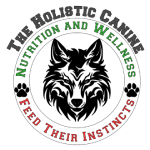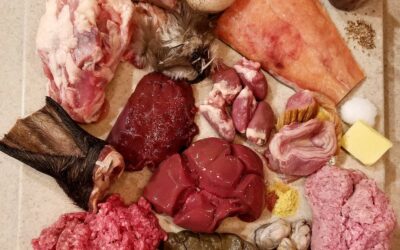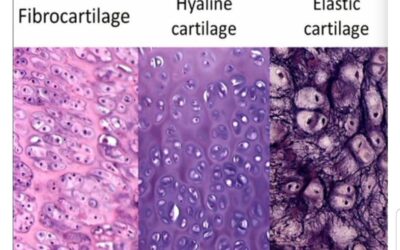Did I get your attention? Good! There is raw feeding purism and then there is raw feeding done correctly and safely. The truth is, not all foods should be fed raw. While meat, organs, bones, and eggs should be fed raw, foods such as fish, shellfish, and most vegetables should not. In this article we will take a closer look at why this is true.
Fish and Thiaminase
Thiaminase, also known as aneurinase, is an enzyme contained within the flesh and viscera (organs) of numerous species of fish and shellfish which has the uncooperative job of metabolizing (breaking down) the B-vitamin thiamin or thiamine (Vitamin B1) into two molecular parts. While this may seem innocent at the surface, it can spell danger in a big way for your dog (and you) if raw fish is being consumed.
Enzymes are essential for metabolism and digestion. They speed up the rate of all biological chemical reactions and enable the breakdown of food. Digestive enzymes are needed to breakdown foods allowing your dog’s body to unlock the nutrients within the foods that his body requires for maintenance, health, metabolism, and life. However, when your dog consumes an enzyme that targets a vital nutrient, we call these “disobliging” enzymes anti-nutrients because they destroy the very nutrients your dog requires to maintain his health and crucial bodily functions. Thiaminase destroys thiamin before your dog’s body has a chance to absorb this essential vitamin.
Thiamin is part of the B-vitamin complex. It is named B1 because it was the very first scientifically discovered vitamin (1897 to be exact, although Vitamins C and D were previously known nutrients that had yet to be “scientifically” isolated) and gave way to the use of the word “vitamin.” Thiamin is an essential nutrient component for energy metabolism. All cells require thiamin to make adenosine triphosphate (ATP), the main energy-carrying molecule. The heart in particular requires a large amount of thiamin! According to Cornell University, without a sufficient absorption of thiamin, “animals [will] have impaired pyruvate utilization, causing increased plasma pyruvate levels and a shortage of cellular ATP. Thiamin deficient animals also have below normal transketolase activity [1].”
The active form of thiamin is known as the coenzyme pyrophosphate (TPP) and is necessary for the conversion of pyruvate to acetyl-CoA, the conversion of alpha-ketogluterate to succinyl-CoA, the conversion of branched-chain alpha-keto acids to acyl-CoA, and the transfer of a 2C fragment from alpha-keto sugars to aldose acceptors in the pentose-phosphate shunt. If you have no idea what this means, just understand that it is vital for energy! If your dog has any shortage of thiamin in the diet and/or is consuming thiaminase via raw fish, this can become a serious health situation.
When your dog (and you) ingests thiaminase, this enzyme cleaves or splits a thiamin (Vitamin B1) molecule into two parts rendering it inactive and unfortunately unable to be restored. Significant ingestion of thiaminase can obviously induce a thiamin deficiency quite quickly causing thiamin-deficiency related conditions to manifest. One of the first signs of deficiency is weight loss and the inability of your dog to maintain a healthy weight. The symptoms of Beriberi in humans are similar to the symptoms your dog could experience, one serious result being an enlarged heart which can be fatal.
According to PetMD, “As described in a controlled study and a retrospective report, the induction stage generally develops within 1 week after animals begin eating a diet severely deficient in thiamine and is characterized by hyporexia (poor appetite), vomiting, or both (neurologic and cardiac dysfunction develop as the condition progresses). Typically, an animal must be thiamine deficient for slightly more than 1 month before the terminal stage is reached. However, once the terminal stage has started, an animal will die within a few days if the deficiency is not corrected immediately…Typically, it can take weeks to months for the development of clinical signs, which are attributable to subchronic deficiency because most diets are not entirely devoid of thiamine. Mitigating factors include the amount of thiamine in the food, nutrient composition of the diet, whether the animal eats a consistent diet, and species and health status of the animal [2].”
What if your dog is only ingesting a small percentage of raw fish? This is a good question! Having audited countless nutrition plans and pet-parent-generated recipes, I can tell you for certain that most meal plans come up short or barely hit vital thiamin requirements especially if following too closely to a ratio such as 80/10/10 or 80/10/5/5. Because thiamin is water-soluble, it must be provided daily in the diet in sufficient amounts. Any hindrances such as from even small amounts of thiaminase can potentially lead to a deficiency condition.
The following list comprises of fish species known to contain thiaminase. For a further list, see note at the bottom [3].
- Alewife
- Anchovy, broad-striped
- Anchovy, Californian
- Bass, white
- Bowfin, Dogfish
- Bream
- Brown bullhead
- Buckeye shiner
- Buffalo fish
- Bull Head
- Burbot
- Capelin
- Carp, Common
- Catfish, channel
- Clams
- Herring, Atlantic
- Herring, Baltic
- Lamprey
- Lobster
- Mackerel, Pacific (Chub)
- Menhaden, Atlantic M
- Menhaden, Gulf
- Mussel, Mediterranean
- Sardine, scaled
- Scallops
- Smelts, Rainbow
- Snapper, Ruby
- Tuna, Skipjack
- Tuna, Yellowfin
- Whitefish, lake
- Whitefish, Round
Fish without thiaminase:
- Bass, smallmouth, largemouth, and rock
- Cod
- Croaker
- Haddock
- Hake
- Halibut
- Mackerel, species Scomber scombrus
- Pike
- Pollack
- Salmon
- Smelt, pond
- Trout, brown, lake, rainbow, & white
- Whiting
How to Avoid Thiaminase
Avoiding fish altogether is not a wise strategy plan. Fish contains a wealth of essential nutrients and fatty acids that your dog needs. Thankfully, test studies show that subjecting thiaminases to heat via the cooking processes will inactive the thiaminase sufficiently to prevent your dog from developing a thiamin-deficiency condition. My recommendation, especially if feeding whole fish with all the viscera, is to lightly poach or steam the fish until it is completely heated through to be sure the viscera are cooked. You can poach or steam fish on the stove or in the oven to safely feed fish to your dog.
Salmon & all Anadromous Fish
You likely noticed that salmon is a fish that does not contain thiaminase. While this may seem all well and good to feed raw, I have more bad news. Salmon should never be fed raw. Feeding raw salmon to your dog can lead to a condition known as salmon poisoning disease (SPD). SPD is a potentially fatal condition caused by a parasite known as Nanophyetus salmincola that itself is infected by a rickettsial organism known as Neorickettsia helminthoeca. This rickettsial organism is what causes SPD in dogs consuming infected raw salmon and anadromous (upstream swimming) fish. Cooking all salmon and anadromous fish will destroy the organism-infected parasite. While freezing the fish in a deep freezer for an extended period of time is an option, my preferred method is to err on the side of caution and lightly poach all salmon.
Symptoms of SPD include vomiting, lack of appetite, fever, diarrhea, weakness, swollen lymph nodes, and dehydration. If your dog shows signs of SPD and is not treated, death can occur within two weeks. Statistically, 90% of untreated dogs with SPD die. It can be treated successfully if caught immediately at the first sign of symptoms. My opinion is to never take a chance of your dog coming down with SPD. Cook all salmon before feeding it to your dog.
In fact, cook ALL fish before feeding. Why take a chance with your dog’s health?
The Ugly Side of Vegetables & Plants
Plants are not exempt from the “bad” list when it comes to a healthful diet and nutrition plan for both our dogs and us. For people, plants can provide extraordinary health benefits as they are often abundant in nutrients and beneficial phytochemicals. But when it comes to our dogs, canines are unfortunately not designed nor equipped to benefit from the plant world as we humans do.
Animals that are designed and equipped to live exclusively on plants are known as herbivores, frugivores, and granivores. Animals that can consume both plants and animal flesh are known as omnivores. We humans are technically omnivores as we are able to perfectly digest and benefit from both plants and animal foods. Why do I bring this up? I do so because many people believe that our dogs are omnivorous rather than the facultative carnivores that they are. This impression was perpetrated by the pet food industry many, many decades ago.
When the pet food manufacturing process known as extrusion was invented in the 1950’s, starch was an essential ingredient that was needed to hold dog food into a dry shape that could be bagged and stored on a shelf. Later, a 1964 lobbying group known as the Pet Food Institute began a campaign to convince pet-parents that commercially manufactured and packaged or canned pet foods were not only the best option for dogs, but the only option a pet needed to provide all of his or her nutritional needs. This lobbying group was also successful at convincing well-meaning pet-parents that table scrapes were dangerous, a dog’s nutritional needs were too complicated, and canine nutrition should be left in the hands of the professionals only. So of course, further convincing the pet-parenting world that dogs are omnivores was all too easy. After all, dogs weren’t dropping dead from the starch-based commercial foods they were now being exclusively fed. (As an FYI, grains were the main starches being used.) And why?
All biological life has the potential to adapt. As a result of decades and thus generations of dogs consuming a high starch diet, some breeds have developed an increased number of gene copies that code for the creation of the amylase enzyme responsible for starch digestion (AMY2B). This discovery has been the modern foundation on which the pet food industry and veterinarians stand to support their belief or claim that dogs are omnivorous. However, a much closer look at a recent study shows this argument has no real foundation. If dogs in general “evolved” from carnivores into omnivores, then ALL dogs would show this evolutionary marker. But this is clearly not the case.
According to an article issued by the National Center for Biotechnology Information [4], “AMY2B copy numbers vary in individuals from 20 dog breeds and find strong breed-dependent patterns, indicating that the ability to digest starch varies both at the breed and individual level…. AMY2Bcopy numbers also varied considerably in a larger set of 171 dogs from 20 different breeds. Mean copy numbers still varied significantly among breeds.” This is a critical finding.
The article goes on to further explain, “Although these observations argue that dogs in general digest starch more efficiently than do wolves, considerable variation in AMY2B copy numbers within the dog population, with diploid copy numbers ranging from 4 to 30, indicates that the ability to handle starch may vary significantly among dogs. In support of this idea, wide reference values for serum amylase activity in blood biochemistry panels indicate strong variability in amylase activity among dogs. Based on the simultaneous increase in AMY2Bcopy number and amylase activity in dogs relative to in wolves, it is reasonable to hypothesize that amylase activity is associated with AMY2Bcopy number within the dog population. Yet, a previous analysis within the dog population did not support this hypothesis (Axelsson et al. 2013).”
Thus, are dogs actually omnivores with the ability to consume and benefit from plant matter? The conclusion to the above article puts it this way, “Increased amylase activity in dogs relative to wolves is associated with high AMY2B copy numbers in dogs, arguing that efficient starch digestion is linked to high copy numbers at this locus. However, this association has so far not been confirmed within the dog population. A lack of association may potentially question a causal link between copy number and amylase activity.”
I believe the most telling proof in this whole argument is the fact that after dogs began consuming a high starch diet, they in general began developing the very same conditions as we humans began to develop when carbohydrates became the foundation of the diet. These conditions include exocrine pancreatic insufficiency, diabetes mellitus, inflammatory bowel disease, chronic skin conditions, and obesity. Not surprisingly, when dogs are taken off of starches, the conditions improve or rectify.
Unnatural foods = unnatural diseases. In other words, species-inappropriate foods lead to avoidable disease conditions.
What does this have to do with vegetables? Everything! Vegetables are carbohydrates and amylase enzymes are required to breakdown all carbohydrates. Having been in the dog profession since 1994, I have seen a LOT of dog stools and many, many health conditions. I have yet to meet a dog that can digest a vegetable given in its whole raw form. If you feed a dog a raw carrot, it comes out the way it was swallowed. I have even seen spinach pieces and lettuce leaves in dog stools! The point is this: the majority of dogs cannot breakdown plant matter (dare I even say, none?!). Thus, it must be mechanically processed via a blender before being offered to your dog in order for the plant matter to provide any benefit whatsoever. (Something to also consider, dogs do not “chew” as their jaws have no lateral movement, nor do they have molars that meet for grinding food!)
If we go back to commercially produced dog food, you will note that all commercial foods are processed. Processed foods are already broken down with the nutrients readily available (albeit synthetic nutrient isolates and inorganic chemicals). Feeding your dog a whole-foods diet requires a more extensive digestive process. Whole-foods require a lot more time (and energy) to break them down to release the nutrients for absorption. If we process vegetables such as through a blender, your dog will be able to better benefit from the nutrients in the same manner as processed foods, HOWEVER this also makes the anti-nutrients readily available and easily absorbed. Here comes the bad news.
Plants contain natural toxins. These toxins are insecticides and pesticides produced by the plant to protect itself from the overconsumption by insects found in its environment and natural habitat. The natural toxins produced in the plants maintain balance within the ecosystem. What these toxins do to insects is disrupt cellular function which translates to also having an accumulative impact on the animals and humans consuming them. The most notable plant toxins are phytates, oxalates, lectins, and saponins.
Phytates have the nasty reputation of binding with minerals in the gut and preventing their absorption. The concern with canine phytate consumption is that phytates bind with key and critical minerals that your dog must have in an abundance. These minerals are calcium, zinc, iron, and phosphorus. This can lead to a mineral deficiency condition if phytates are fed to your dog regularly. Phytates are found in seeds, nuts, grains, and legumes, legumes being the greatest perpetrators. Dogs should NEVER consume grains or beans. These are inappropriate and can cause more problems than any possible benefit. Phytase can be reduced by soaking, sprouting, and fermenting, but they can never be removed completely.
Oxalates are found in the most nutritional powerhouses. Oxalates not only bind with calcium, but they interfere causing a potential risk for crystal formation within the tissues leading to arthritis-type symptoms as well as the formation of kidney stones. Oxalates are abundant in dark green leafy vegetables with kale and spinach leading the list, as well as collard greens, mustard greens, chard, beet greens, okra, carrots, celery, broccoli, grains, beans, nuts and more. Cooking reduces the oxalates. Consuming a large amount of calcium and magnesium with foods containing oxalates is helpful as the calcium and magnesium will bind with the oxalates in the stomach to prevent their absorption. However, then your dog has a reduced amount of absorbable calcium and magnesium. High oxalate veggies are best left to a bare bone minimum and should be cooked before feeding them to your dog. Make sure to discard the cooking water.
Lectins have the nasty drawback of creating a disruption in the functioning of the cells lining the gut layer known as the epithelium. These cells have the vital role of preventing undigested food particles from passing through the gut wall and into the bloodstream. Undigested food particles in the bloodstream can trigger an immune response leading to systemic inflammation. And if this is not enough, research has shown that lectins interfere with the gut microbiome. Foods high in lectins are wheat germ, legumes, and grains as the highest followed by tomatoes, peanuts, potatoes, bell peppers, garlic, peas, nuts, and seeds. Cooking and fermenting reduces lectins. Since these foods are not species-appropriate, I recommend they not be fed to your dog.
Saponins, like lectins, disrupt epithelial function along with creating additional digestive dysfunction. Worse, a connection has been found between saponins and red blood cell damage, enzyme inhibition, and thyroid disruption. Quinoa is thus far the highest food-source of saponins followed by oats and legumes. Saponins cannot be removed. Avoid feeding any foods containing saponins to your dog. These are not worth the risk!
It can be clearly seen that a raw diet doesn’t necessarily mean that every single food offered to your dog should be in its raw state. Plants pose a wealth of issues for animals not developed to consume them. Cooking helps with reducing anti-nutrients and increasing digestibility. My recommendation is to lightly steam vegetables* followed by mashing or pureeing them to make them more bioavailable. Secondly, never feed your dog grains or legumes. And lastly, soaking seeds and nuts is helpful to reducing anti-nutrients. However, almost every dog will pass seeds and nuts into the stools the same way they consumed them. They simply are not digestible to any animals except granivores (birds).
For more lessons and education, join our Facebook group!
©2019 Kimberly Lloyd, PhD, BCHHP, Cert Raw Dog Food Nutritionist
*zucchini and cucumbers can be fed raw.
[1] http://poisonousplants.ansci.cornell.edu/toxicagents/thiaminase.html
[3] http://www.wetwebmedia.com/ca/volume_6/volume_6_1/thiaminase.htm



